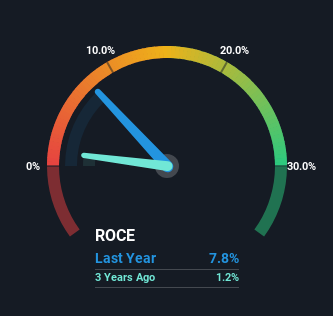- India
- /
- Energy Services
- /
- NSEI:JINDRILL
Investors Will Want Jindal Drilling & Industries' (NSE:JINDRILL) Growth In ROCE To Persist

To find a multi-bagger stock, what are the underlying trends we should look for in a business? Firstly, we'll want to see a proven return on capital employed (ROCE) that is increasing, and secondly, an expanding base of capital employed. This shows us that it's a compounding machine, able to continually reinvest its earnings back into the business and generate higher returns. With that in mind, we've noticed some promising trends at Jindal Drilling & Industries (NSE:JINDRILL) so let's look a bit deeper.
Return On Capital Employed (ROCE): What Is It?
For those who don't know, ROCE is a measure of a company's yearly pre-tax profit (its return), relative to the capital employed in the business. The formula for this calculation on Jindal Drilling & Industries is:
Return on Capital Employed = Earnings Before Interest and Tax (EBIT) ÷ (Total Assets - Current Liabilities)
0.078 = ₹1.3b ÷ (₹20b - ₹4.0b) (Based on the trailing twelve months to December 2023).
Thus, Jindal Drilling & Industries has an ROCE of 7.8%. On its own that's a low return, but compared to the average of 5.7% generated by the Energy Services industry, it's much better.
Check out our latest analysis for Jindal Drilling & Industries

While the past is not representative of the future, it can be helpful to know how a company has performed historically, which is why we have this chart above. If you'd like to look at how Jindal Drilling & Industries has performed in the past in other metrics, you can view this free graph of Jindal Drilling & Industries' past earnings, revenue and cash flow.
The Trend Of ROCE
Like most people, we're pleased that Jindal Drilling & Industries is now generating some pretax earnings. While the business is profitable now, it used to be incurring losses on invested capital five years ago. Additionally, the business is utilizing 22% less capital than it was five years ago, and taken at face value, that can mean the company needs less funds at work to get a return. The reduction could indicate that the company is selling some assets, and considering returns are up, they appear to be selling the right ones.
On a side note, we noticed that the improvement in ROCE appears to be partly fueled by an increase in current liabilities. Essentially the business now has suppliers or short-term creditors funding about 20% of its operations, which isn't ideal. It's worth keeping an eye on this because as the percentage of current liabilities to total assets increases, some aspects of risk also increase.
Our Take On Jindal Drilling & Industries' ROCE
In summary, it's great to see that Jindal Drilling & Industries has been able to turn things around and earn higher returns on lower amounts of capital. And with the stock having performed exceptionally well over the last five years, these patterns are being accounted for by investors. With that being said, we still think the promising fundamentals mean the company deserves some further due diligence.
On the other side of ROCE, we have to consider valuation. That's why we have a FREE intrinsic value estimation for JINDRILL on our platform that is definitely worth checking out.
For those who like to invest in solid companies, check out this free list of companies with solid balance sheets and high returns on equity.
New: Manage All Your Stock Portfolios in One Place
We've created the ultimate portfolio companion for stock investors, and it's free.
• Connect an unlimited number of Portfolios and see your total in one currency
• Be alerted to new Warning Signs or Risks via email or mobile
• Track the Fair Value of your stocks
Have feedback on this article? Concerned about the content? Get in touch with us directly. Alternatively, email editorial-team (at) simplywallst.com.
This article by Simply Wall St is general in nature. We provide commentary based on historical data and analyst forecasts only using an unbiased methodology and our articles are not intended to be financial advice. It does not constitute a recommendation to buy or sell any stock, and does not take account of your objectives, or your financial situation. We aim to bring you long-term focused analysis driven by fundamental data. Note that our analysis may not factor in the latest price-sensitive company announcements or qualitative material. Simply Wall St has no position in any stocks mentioned.
About NSEI:JINDRILL
Jindal Drilling & Industries
Provides drilling and related services to the oil and gas exploration companies in India.
Solid track record with excellent balance sheet.
Market Insights
Community Narratives



